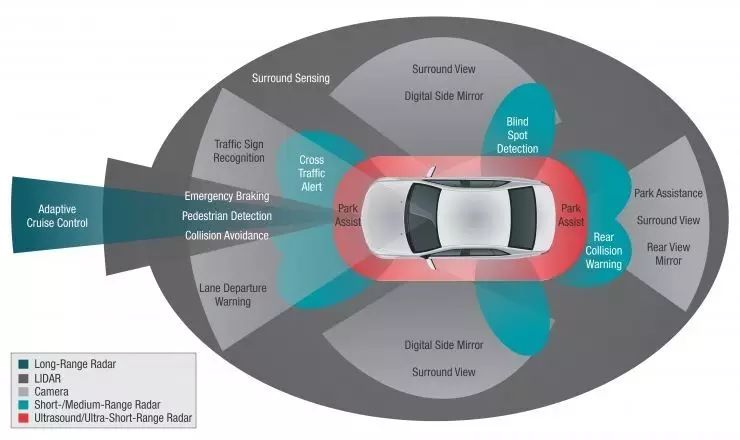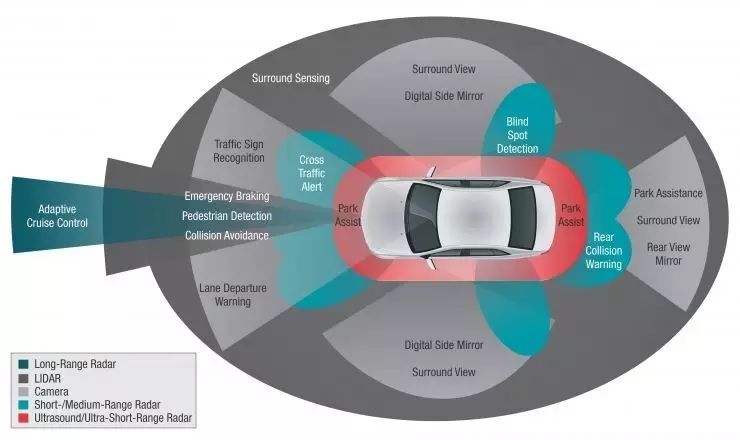Editor’s note: In August this year, Lei Feng Network will hold the “Global Artificial Intelligence and Robotics Innovation Conference” (GAIR) in Shenzhen, where we will announce the “Top 25 Innovative Companies in Artificial Intelligence and Robotics”. Minieye is one of the companies we are focusing on. Today, we invite Minieye’s founder and CEO, Liu Guoqing, to share insights on ADAS.

Liu Guoqing, founder and CEO of Minieye, holds a PhD in Computer Engineering from Nanyang Technological University, Singapore, and has published over 10 research papers in top conferences and journals in artificial intelligence (AAAI, IJCAI, etc.), holding 9 domestic and international invention patents. He returned to China in 2013 to establish Minieye, leading a team of over thirty returnee PhDs and excellent engineers to independently develop in-vehicle visual perception technology. Currently, Minieye has established partnerships with several OEMs and Tier 1 suppliers.
With many ADAS suppliers, how to enter the market?
Lei Feng Network: What do you think about the current state of the ADAS market in China?
Liu Guoqing: Whether in the automotive industry or the capital market, ADAS is a hot topic, with a significant increase in demand and a lot of money being invested.
However, ADAS is still an emerging field in China, and most teams are still in an early exploratory stage. This leads to many peers having a relatively one-sided understanding of ADAS application scenarios, lacking sufficient expectations for the huge gap from demo performance to product-level standards, and the algorithms and products developed often lack systematic library testing and road testing, even having many blind spots regarding the needs and requirements of OEM customers.
Improving this situation requires a lengthy process, so current market demand is still primarily met by foreign suppliers.
Lei Feng Network: Briefly introduce what Minieye is currently doing.
Liu Guoqing: The founding team of Minieye was established in Singapore in 2012, initially as a research project on advanced driver-assistance systems (ADAS) funded by the Singapore government’s MDA. We focus on the R&D of in-vehicle visual perception technology and products, using visual sensors and algorithms to identify various targets in traffic scenes, analyzing, understanding, and predicting the states and behaviors of these targets to help improve driving safety and comfort.
Currently, our technology is mainly applied in driving assistance and semi-automated driving fields.
Lei Feng Network: With many suppliers involved in ADAS, what is your entry point?
Liu Guoqing: Professionalism and localization are our two advantages.
On one hand, if we expect to make significant progress in the fields of ADAS, semi-automated driving, or even autonomous driving, professionalism is a hurdle that must be crossed. Because these products are directly related to personal safety, only with sufficiently professional technology and guaranteed product reliability can we transition from aftermarket to OEM, from warning to control.
For example, if you want to enter the OEM market in the U.S., you must first install your system in their test vehicles and run for four to five hundred kilometers. If any false positives, missed detections, or frame drops are found, then sorry, please go home and continue to improve. Therefore, the threshold is very high, enough to block the vast majority of players. To enhance the professionalism of our technology, Minieye has made many efforts, such as standardization (involving international standards, association standards, and corporate standards related to ADAS) throughout the development and testing process, and collecting data from ten thousand kilometers of driving every day to cover as many working conditions as possible.
On the other hand, localization is also a major advantage for us. This includes several aspects: data, functions, and experience localization. The degree of adaptation of models to local conditions is directly related to the localization of training data, while the functions and experience are easier to understand.
For example, in China, there are many cars on narrow roads, and electric bicycles and pedestrians are everywhere, with most collisions occurring at low speeds. Therefore, collision avoidance functions at low speeds are more useful in China than in Europe and the U.S. Moreover, different countries have significant differences in how drivers define danger, and Chinese people tend to be more relaxed, so if you implement a European or American warning mechanism, users will find it annoying.
Lei Feng Network: The decisive factor for the widespread application of ADAS is cost. If everyone is heading towards “low cost,” how can product differentiation be achieved?
Liu Guoqing: First, ADAS includes many functions, and it is not easy to excel in each function point, so different companies can completely choose different niche markets to focus on. This is particularly important for startup teams.
Additionally, I want to emphasize that reducing costs is crucial for the ADAS industry. However, if the pursuit of low cost ignores the improvement of technical levels and product refinement, that would be a significant problem. When discussing professional and advanced algorithms, people often think of Silicon Valley or Israel, while in China, it seems that the only goal is to make things cheaper.
In the field of artificial intelligence, there are several top international conferences, and in recent years, over a third of the results in these conferences have involved our Chinese compatriots, so Chinese people are not inferior to anyone when it comes to algorithms. Furthermore, the rapid development of the semiconductor and sensor industries will significantly help reduce the costs of ADAS products.
Lei Feng Network: Besides cost, how can ADAS be made more grounded and usable for the majority of car owners?
Liu Guoqing: I understand that being grounded means meeting local needs, which mainly involves the functions and experience I mentioned above. The best way to achieve this is to iterate the product based on user feedback.
The common mentality in traditional industries is this: once you buy something from me, please don’t come back, because I see you thinking about after-sales, repairs, and returns. This is not right; we should learn from internet companies.
Lei Feng Network: A mature ADAS system is not built overnight; starting from scratch requires 3 to 4 years of experience accumulation, and collaborating with OEMs also takes several years. As a startup, how do you ensure the survival of the company during this long cycle?
Liu Guoqing: The best way is to develop business to create self-sustaining capabilities. Since last year, we have already received orders in the aftermarket.
Lei Feng Network: How does Minieye approach the OEM and aftermarket? What do you think of the current trend of adding ADAS functions to aftermarket dash cameras and rearview mirrors?
Liu Guoqing: There is no special strategy for OEM; we focus on solid development, taking one step at a time.
In the aftermarket, we have chosen a few complementary partners to explore together, providing both complete hardware functional modules and software solutions, which is quite flexible.
Lei Feng Network: There is a saying in the industry that Mobileye has high costs, which gives some startup companies opportunities to survive. In your opinion, why can startup companies offer low-cost ADAS while Mobileye cannot?
Liu Guoqing: Mobileye’s hardware costs are not high; the EYEQ series chips are developed in-house, so the costs are low. However, from the perspective of R&D costs, foreign R&D costs are much higher than domestic ones, and the initial investment in chips is also very large, which raises Mobileye’s overall costs.
Moreover, Mobileye adopts a global pricing strategy, and it does not seem likely to significantly lower prices for the Chinese market. This presents an opportunity for domestic companies.
What is the value of ADAS for cars?
Lei Feng Network: In complex traffic scenarios (including but not limited to various lighting, weather, and road conditions), what is the accuracy rate of Minieye in accurately recognizing targets? Is this accuracy rate the only indicator of ADAS quality?
Liu Guoqing: The recognition rate usually refers to how many of the 100 cars your system can detect. From a technical perspective, talking about recognition rates alone is meaningless.
For example, if there are 10 images, 5 of which are cars and 5 are trees, and a system recognizes all 10 images as cars, it would score 100% on the recognition rate, but it would also generate a lot of false positives. Therefore, in professional development, the algorithm evaluation system must consider both sensitivity and specificity. Or to put it simply, we should maximize the recognition rate while maintaining an acceptable false positive rate.
On the other hand, technical indicators and testing data are also directly related. Achieving 100% accuracy on a database of 1,000 images is less impressive than achieving 98% on a database of 100 million images.

Lei Feng Network: ADAS systems are mostly based on cameras, with the technical foundation being computer vision. What considerations does Minieye have regarding camera selection for ADAS? How important is the camera in the ADAS system? What differences exist between monocular and binocular solutions, and what are their respective advantages and disadvantages?
Liu Guoqing:Wide dynamic range, high sensitivity, machine-friendly.
Cameras are very important for ADAS. For example, if you suddenly move from a dark place to a bright place, such as exiting a tunnel, if the camera’s dynamic and exposure response is not timely, it will be overexposed, and no matter how good the algorithm is, it will be difficult to solve the problem.
Binocular systems have a short effective distance, require high computational load and mechanical structure, and do not handle weather conditions like rain or overexposure well, but they excel in quantitative distance measurement. Monocular systems, on the other hand, are the opposite.
Lei Feng Network: Does the ADAS solution currently face challenges in processors, sensors, and algorithms?
Liu Guoqing:Yes. ADAS camera modules need to be customized, and different ADAS functions have different requirements for cameras. Algorithms related to images inherently require significant computational resources, so the performance of the chips is often a high requirement.
If you want to incorporate deep learning into your system, the challenges are even greater. The main challenge in algorithms is to robustly recognize targets in complex scenarios.
Lei Feng Network: In your opinion, why is pedestrian recognition still a long way from productization? What are the difficulties?
Liu Guoqing: Perception of pedestrians is more challenging than that of cars. On one hand, there is greater variability in pedestrian data, with different postures (standing, squatting), heights, weights, and various outfits, as well as various occlusions in urban environments, leading to significant differences in appearance. This variability leads to increased model complexity, which in turn raises the requirements for chip computing power.
However, Mobileye’s products in both the OEM and aftermarket have this capability, and our company will also launch this feature within the year, so the distance to productization is not far.
Lei Feng Network: In your opinion, what is the value of ADAS for automakers and drivers, respectively? What significance does it have for the future development of automobiles?
Liu Guoqing:ADAS is a necessary path to driverless driving. For drivers, the value is of course a safer and more comfortable driving experience. Therefore, if ADAS functions are well implemented, they can help OEMs increase sales volume. Additionally, it can help OEMs better layout the autonomous driving industry.
Lei Feng Network: In August this year, Lei Feng Network will hold the “Global Artificial Intelligence and Robotics Innovation Conference” (GAIR) in Shenzhen. What are your views on the future trends of artificial intelligence?
Liu Guoqing: The future of artificial intelligence will inevitably be a large system, much like the human brain in biology, where there are many centers, each handling a specific operation, and then the system interacts. Each block that needs to be handled well is very complex, such as voice and image. Solving the entire artificial intelligence problem will be a huge project that requires collaboration among the world’s best scientists and engineers.
Artificial intelligence systems roughly consist of three major components: perception, decision-making, and execution. Visual perception will be one of the most challenging yet promising directions for future development, as about one-third of the human brain is dedicated to processing visual information.
Exciting Q&A:
Q: Is there a publicly available ADAS evaluation image dataset in the industry for ADAS manufacturers to test recognition rates? Otherwise, stating a recognition rate is meaningless?
Liu Guoqing: Currently, there is no such database in the industry. The possibility of having one in the future is also unlikely.
The reason is that different companies use different sensors, and the training data collected will have some differences, so it is impossible to use a universal test library for fair evaluation. However, it is possible to establish some testing standards so that everyone can test under the same rules, which would yield comparable results.
Recognition rate is an important indicator in ADAS, but it needs to be considered alongside other indicators to be meaningful. Additionally, it is essential to consider under what rules the recognition rate and similar indicators were tested when evaluating ADAS technology.
